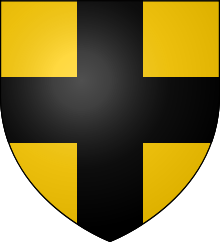John de Vesci
| John de Vesci | |
|---|---|

Coat of arms of John de Vesci
|
|
| Buried | Alnwick Abbey |
| Noble family | de Vesci |
| Spouse(s) | 1. Mary of Lusignan 2. Isabella de Beaumont |
| Father | William de Vesci |
| Mother | Agnes de Ferrers |
John de Vesci, sometimes spelt Vescy, was a prominent 13th-century noble. He was the eldest son of William de Vesci and Agnes de Ferrers. He married firstly Mary of Lusignan and secondly Isabella de Beaumont. John died c. 1289.
He succeeded to his father's titles and estates upon his father's death in Gascony in 1253. These included the barony of Alnwick and a large property in Northumberland and considerable estates in Yorkshire, including Malton. Due to his being under age, King Henry III of England conferred the wardship of John's estates on a foreign kinsmen, which caused great offence to the de Vesci family.
John sided with Simon de Montfort, 6th Earl of Leicester during the barons' rebellion against King Henry III, known as the Second Barons' War of 1263–64. He was summoned to the great parliament of January 1265, the first directly elected parliament in medieval Europe. During the battle of Evesham on 4 August 1265 he was wounded and taken prisoner. Released sometime afterwards he admitted to compound for his estates after the Dictum of Kenilworth.
During 1267, he participated with some of the northern barons in another rising, however Prince Edward went north with an army and John was forced to submit. After being treated well by Edward, he became a devoted friend. John went with Edward on his crusade to Palestine between 1271 and 1272. He was one of the two barons who led Eleanor of Castile from the presence of her husband Edward, when he was operated upon for his poisoned wound.
In 1273 he was made governor of Scarborough Castle. In 1275, John was part of an expedition against Guðrøðr Magnússon, who was leading an uprising on Mann, in an attempt to establish himself as king. The Chronicle of Mann and Chronicle of Lanercost indicate that a Scottish fleet made landfall at Ronaldsway, on 7 October. The Chronicle of Lanercost records that John de Vesci and other Scottish magnates arrayed their forces on St Michael's Isle, and sent forth an embassy offering Guðrøðr and his followers peace. Guðrøðr refused, and the following morning, before sunrise, both chronicles indicate that his forces were utterly defeated during the battle of Ronaldsway. According to the Chronicle of Mann, 537 rebels were slain by the Scots.
...
Wikipedia
